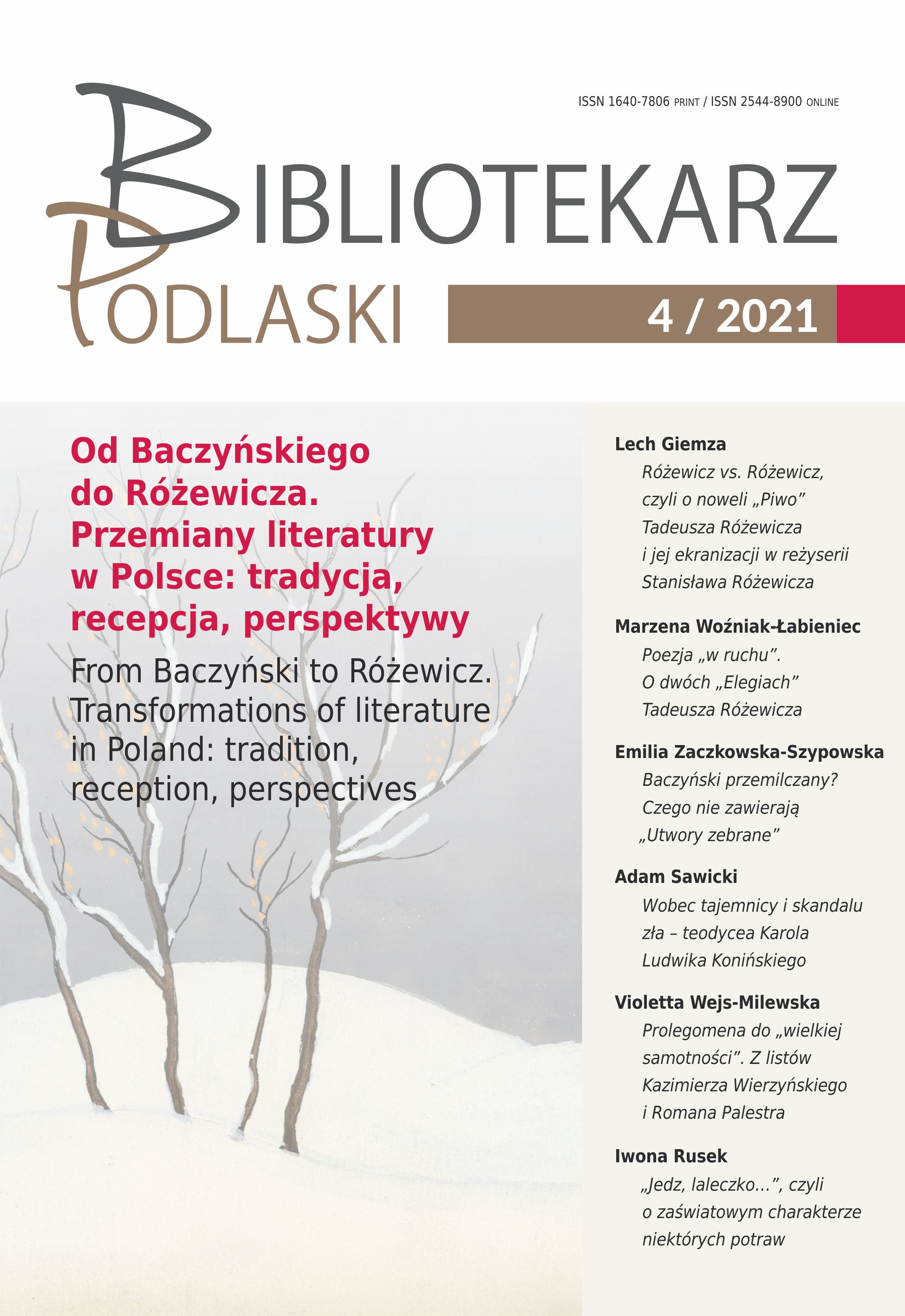Abstract
The author of this article discusses the textual changes in the subsequent publications of Tadeusz Różewicz’s two Elegie [Elegies] in the context of the artistic phenomenon of poetry “in motion”, also indicating the consequences of these changes. She agrees with the poet that the poem is a frequent phenomenon, while poetry is an extremely rare construct. Poetry, in contrast to the poem, does not, according to Różewicz, have a beginning and an end. In our times, therefore, it is not the finished form of a given poem that counts for a potential recipient, but the very process that forms a given text. Therefore, only poetry “in motion”, heading towards the unknown, still makes sense.
References
Anioł w majtkach Polixeny. O Miłoszu i Różewiczu rozmawiają Przemysław Dakowicz i Jan Stolarczyk, [w:] P. Dakowicz, Poeta (bez)religijny. O twórczości Tadeusza Różewicza, Łódź 2015.
Brzozowski J., Notatki na marginesie dwóch wierszy Tadeusza Różewicza, „Czytanie Literatury” 2013, nr 2.
Fiut A., Dialog niedokończony, „Kwartalnik Artystyczny” 2006, nr 2.
Kruszewski W., „Niepokój” Tadeusza Różewicza. Notatki do historii projektu artystycznego, [w:] Ewangelia odrzuconego. Szkice w 90. rocznicę urodzin Tadeusza Różewicza, Warszawa 2011.
Majchrowski Z., Otwieranie „Kartoteki”, [w:] T. Różewicz, Kartoteka. Kartoteka rozrzucona, Kraków 1997.
Różewicz T., Elegia, „Odrodzenie” 1945, nr 4.
Różewicz T., Elegia na powrót umarłych poetów, „Pokolenie” 1946, nr 1.
Różewicz T., Margines, ale…, Wrocław 2010.
Skrendo A., Przepisać „Niepokój”, „Pogranicza” 2006, z. 1.
Twórcy o Różewiczu, „Poezja Dzisiaj” 2006/2007, nr 54–55.
Articles published in the “gold open access” mode on the basis of a non-exclusive license agreement between the publisher and the author. Permitted use:
- the publication may be read and stored on any device,
- the publication may be cited (with obligatory reference to the author, the title of the text, as well as the full title, bibliographic address of the issue and page of the journal)
The editorial team of “Bibliotekarz Podlaski” implements an open access policy by publishing materials in the form of the so-called Gold Open Access. From volume 42 (issue 1/2019), the journal is available under the Creative Commons license (Attribution – ShareAlike: CC BY-SA).
The key declarations of the Open Access and Open Science movement, which we fully support, are available on the CEON Open Science website.
COPYRIGHT:
The editorial team of “Bibliotekarz Podlaski” implements an open access policy by publishing materials in the form of the so-called Gold Open Access. The journal is available under the Creative Commons license – Attribution – ShareAlike 4.0: International: CC BY-SA 4.0).
The key declarations of the Open Access and Open Science movement, which we fully support, are available on the CEON Open Science website.
“Bibliotekarz Podlaski” allows its readers to read, download, copy, distribute, print, search and link to the full content of articles. We enable full, immediate, unlimited (both in a territorial, temporal and technical sense) open access to all published content, in accordance with the principle that freely available research increases and accelerates the global development of science and the exchange of knowledge.
The editorial team of “Bibliotekarz Podlaski” encourages authors to place articles published in the journal in open repositories (after the review or the final version of the publisher), provided that a link to the journal’s website is provided.
The journal does not charge the authors any fees for accepting and publishing their texts.


